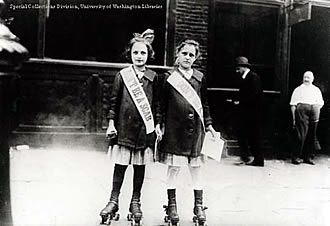
Lesson Seventeen: Reform and the Pacific Northwest, 1880-1920
Labor families protest (left). Protest and reform were events that involved the entire family, including young girls who, besides their parents, were part of the labor force. We do not know the date of this photograph, but these children by asking
us to not be a "scab" could be making this appeal on behalf themselves, their mother or their father. (Special Collections, University of Washington, Social Issues Files Dc/iii. Neg.335)
In the decades between 1880 and 1920 the United States produced a variety of social and political movements devoted to the improvement of all areas of life. These movements responded in many respects to the conditions being created by the new urban and industrial order. Many Americans were uncomfortable with the rapid and disruptive changes that were occurring, and they participated in movements that sought to soften the impact of those changes. Others aspired to create a more efficient world, hoping to make adjustments to the prevailing system so that it ran more smoothly. Still others proposed to overturn the prevailing system in some fashion, and replace it with another that would be more humane or equitable. In textbook accounts of U.S. history, these social and political movements, many of which overlapped, are often summarized as Populism, Progressivism, the Rise of Organized Labor, and Radicalism.
The various reform and radical movements that emerged across the country took especially powerful hold in the Pacific Northwest. Perhaps because so many parts of regional society were still in their "formative" phases during the decades surrounding 1900, these movements exerted a more forceful and lasting impact in the region than they did elsewhere. The history of Washington, Idaho, and Oregon was profoundly shaped by the various protests, reforms, and radical proposals that emerged across the country between 1880 and 1920. The impact of populist and progressive reforms on the region offers good case studies.
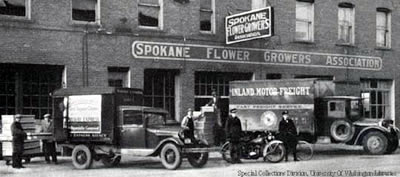
Farmers' cooperatives (right) in Washington go back to 1890. By 1920, there were close to 100 groups organized to promote and market agricultural produce from eggs to the cut flowers sold by the Spokane Flower Growers Association. (M.C. Puhr. Spokane, 1940. p.16.)
Populism was many things, but at bottom it might be seen as a movement by farmers to enlist government to help them meet the challenges presented by the new industrial order. Farmers felt tremendous pressure from: the growing and threatening concentration of economic power in the hands of railroads, banks, farm-equipment manufacturers, and other corporations; the booms and busts in the economy of the late 19th century; the growing problem of overproduction, which drove down prices for the things they produced; and deflation. Organizing into social groups, economic cooperatives, and political parties, farmers pressed for government regulation of railroads and other powerful financial interests, a new currency system to end deflation and reduce the power of banks, a more equitable means of distributing the public domain so that big owners (specifically, railroad companies) would not get more than their share of lands, and other economic and political reforms designed, in the words of one group, to "secure the toilers a proper share of the wealth they create." The states of Washington, Oregon, and Idaho developed Granges and Farmers Alliances, and contributed to the rise of populist third parties during the later 19th century. As the accompanying reading by Marilyn Watkins ("Contesting the Terms of Prosperity and Patriotism") shows, the influence of populist ideas persisted well into the 1920s.
Two kinds of evidence may serve to illustrate the relatively strong presence of populism in the Pacific Northwest. One is electoral returns. During the 1890s, the People's Party enjoyed comparative success at the polls in the Northwest, particularly when one considers just how hard it has been in the United States for a third party to take votes away from the Democrats and Republicans. In its first year on the ballot, in 1892, the People's Party won 30% of the votes cast for President in the three states of the Pacific Northwest. In Idaho (where the leading role of silver mining made the populist stand against the gold standard quite popular), the Populist candidate for President, General James B, Weaver, won 54% of the popular vote. Voters in Washington and Oregon gave Weaver 22% and 16% of the vote, respectively, and also elected a handful of Populist legislators to state houses. In the 1894 elections, Populists replaced Democrats as the second party of Washington; in 1896 Populists and Democrats "fused" in the Evergreen State to elect as Governor the Populist John R. Rogers of Puyallup, and also took control of the state legislature. Populists' accomplishments in Olympia were few and their prevalence was short lived, yet their success in the state and around the region exceeded that of most Populists elsewhere.
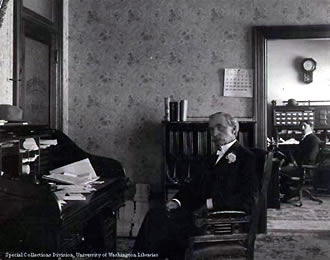
Governor John R. Rogers's home town of Puyallup was a major center of Populist sentiment. (Special Collections, University of Washington, Portrait Files. neg. #6347.)
The constitution for the state of Washington, written in 1889, stands as another instance of lasting populist influence. The document reflects very clearly the concerns of farmers (and others) who felt strongly about regulating railroads and other monopolies, reducing the influence of big business on government officials, and guaranteeing the rights of individuals. One provision of the constitution "banned gifts or loans of public money and credit to the private sector. These prohibitions were aimed primarily at the railroad companies, which often refused to build lines to communities unless the public helped pay for the railroad stations and other improvements." The constitution contained other clauses based on a suspicion of big business; one provision gave the state control over the disposition of most tidelands, largely in an effort to prevent them from being sold to railroads or other private interests. Other sections of the constitution attempted to reduce the influence of big business on government. For example, compared to people in other states Washingtonians vote on more executive offices—e.g. commissioner of public lands and superintendent of public instruction—because those writing the constitution wanted to limit the appointive powers of elected officials (who seemed too susceptible to lobbying by corporate interests) and permit voters to select for themselves a wide range of officials. Finally, populists pushed to safeguard the rights of individuals in Washington. In many respects—such as the right to privacy, limitations on police searches, guarantees to a trial by jury, the right to own guns, and equal protection for women—the state constitution protects individual rights more zealously than does the federal constitution. (This information, including the quotation, comes from articles by Hugh Spitzer on the Washington state constitution, Seattle Post-Intelligencer, Nov. 16, 18, 19, 20, 1997.) Many populist ideas remain in force in the Washington state constitution.
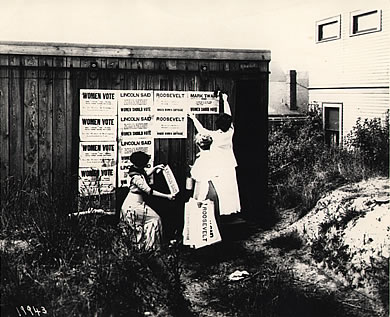 If Washington became known for the influence of populism, Oregon became quite closely identified with the multifaceted movement known as progressivism in the years between 1890 and 1920. When the great progressive Woodrow Wilson visited the state in 1911 (as governor of New Jersey, one year before he won election to the U.S. Presidency), he was struck by how much the reform movement had captured Oregon: "In the East I am counted intensely progressive," he said. "In Oregon I am not so sure." Wilson was observing the accumulation of a variety of new laws and procedures since 1890. Wary about the ability of average people to enact the laws they wanted, reformers in Oregon (including populists as well as progressives) focused on opening up the political process to citizens while reducing the power of "the lawmaking monopoly," which was correctly identified with leading corporate interests, including the railroad.
If Washington became known for the influence of populism, Oregon became quite closely identified with the multifaceted movement known as progressivism in the years between 1890 and 1920. When the great progressive Woodrow Wilson visited the state in 1911 (as governor of New Jersey, one year before he won election to the U.S. Presidency), he was struck by how much the reform movement had captured Oregon: "In the East I am counted intensely progressive," he said. "In Oregon I am not so sure." Wilson was observing the accumulation of a variety of new laws and procedures since 1890. Wary about the ability of average people to enact the laws they wanted, reformers in Oregon (including populists as well as progressives) focused on opening up the political process to citizens while reducing the power of "the lawmaking monopoly," which was correctly identified with leading corporate interests, including the railroad.
"Women Should Vote" (right). Women worked in a variety of ways to publicize their efforts to gain the right to vote.
Thus Oregon became associated with that current of progressive reform that focused on making government more responsive to people's wishes. It passed laws to: adopt the Australian ballot (1891) to enable secret balloting; permit the people to create legislation through initiatives and to review acts of the legislature through referenda (1898-1902); create direct primaries so that the voters, and not elected officials, could choose U.S. Senators (in two stages, 1904 and 1908); regulate campaign expenditures (1908); permit voters to recall elected officials (1908); create a presidential preference primary (1910); establish a public utilities commission (1911); and extend the suffrage to women (1912). Using their power to pass laws without going through the legislature (as well as their new abilities to press legislatures to pass laws before the citizens beat them to it, and to approve or veto laws passed by the legislature), Oregonians also enacted a host of other progressive reforms in areas outside the political process: a ten-hour day for women workers (1903); local-option prohibition (1904); railroad rate regulation (1912); workmen's compensation (1913); statewide prohibition (1914); and abolition of capital punishment (1914; reversed in 1920, abolished again in 1964, and restored anew in 1984). Oregon was not always the first state in the Union to enact specific reforms, but it was consistently one of the earliest to enact progressive political reforms, and it adopted more reforms more quickly than virtually every other state. Thus it became known as "The Laboratory for Political Democracy." Washington and Idaho also adopted numerous reforms, but Oregon remained most closely identified with the progressive political tradition—a factor that may help to explain its distinctive 20th-century politics and its early and thorough conversion to environmental regulations during the 1960s and 1970s.
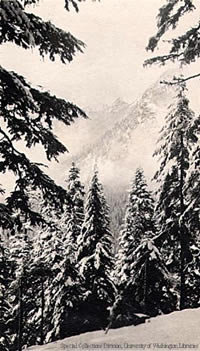
Progressivism affected more than the political process. The reform movement encouraged such practices as municipal ownership of utilities and the development of urban planning. Seattle built a publicly owned water system during the 1890s, and by 1902 had added a municipal power system. Portland, Tacoma, Spokane, and Seattle also launched more rigorous city-planning programs in this era, which led to the development of elaborate park and street systems. Progressivism is also associated with the rise of conservation. The federal government led the way in this reform in the Pacific Northwest, establishing some of the nation's first forest reserves (later known as national forests) in the region during the 1890s—often in the face of complaints from state and private interests—and creating Mount Rainier National Park in 1899 and Crater Lake National Park in 1902. [See Also: The Campaign to Establish Mount Rainier National Park, 1893-1899, By Theodore Catton.] The reading by Abigail Scott Duniway, documenting the campaign for women's suffrage, documents another aspect of progressive reform. The Pacific Northwest, and indeed the Far West in general, extended the suffrage to women before other parts of the country did. This was another example of a reform movement having a relatively stronger effect in the region.
National Forests: Denny Peak and The Tooth, near Snoqualmie Lodge, August, 1947. (Special Collections, University of Washington, from the library of Winona Baily.)
Given the pronounced impact of populism and progressivism (and utopianism and labor radicalism) on the Pacific Northwest, how does one explain the region's receptivity to reform movements? One socialist claimed during the 1890s that Washington seemed to be home to "more 'isms' and 'osophies' than any other state." Why was that?
A number of answers come to mind, although they are more suggestive than definitive. I speculate that reform movements enjoyed more success in the Pacific Northwest in large part simply because people believed they would have a better chance of succeeding there. The Pacific Northwest struck Americans as a relatively new place. Although Oregon had been a state since 1859, its greatest population growth occurred after the arrival of transcontinental railroads during the 1880s. It seemed new to many Americans who were just beginning to discover it, thanks in large part to promotional materials distributed by railroads. The populations of Washington and Idaho similarly consisted primarily of recent arrivals. Moreover, those two states were themselves brand new, having been admitted to the Union in 1889 and 1890, respectively. As the case of the Washington state constitution illustrated, reformers could have a clear influence on how the new governments for the two states were organized.
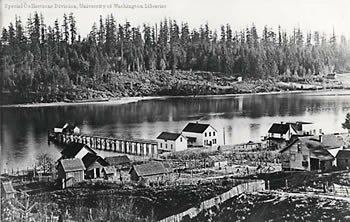 Utopian Communities (right). Home (located in Pierce County, Washington) was one of several utopian colonies created in Washington State. It was a planned development of sorts, with each family receiving an acre plot for both a house and land to grow food. If you moved there you were free to speak your mind, but you could not force anyone else to your views. (Special Collections Division, University of Washington, Social Issues Files Ac. neg. #11264.)
Utopian Communities (right). Home (located in Pierce County, Washington) was one of several utopian colonies created in Washington State. It was a planned development of sorts, with each family receiving an acre plot for both a house and land to grow food. If you moved there you were free to speak your mind, but you could not force anyone else to your views. (Special Collections Division, University of Washington, Social Issues Files Ac. neg. #11264.)
In a word, the Pacific Northwest seemed malleable. And this condition actually helped to attract reformers and radicals of various stripes to the region. In the mid-19th century, American newcomers in the region had demonstrated a strong impulse to imitate that which they had left behind in the eastern states. Now, the West and Northwest became identified as places where one could innovate more readily. Populists, progressives, and radicals believed that they could enact in the Northwest their proposals for change that had met so much resistance elsewhere. This conviction helps to explain, for example, why so many utopian communities were created around Puget Sound in the years between 1885 and 1915—visionaries were certain they had a better chance to succeed in the Northwest, compared to elsewhere. And once model communities had proven themselves in the remote Northwest, utopians supposed, they would have a good chance of being adopted across the country. (See Charles P. LeWarne, Utopias on Puget Sound, 1885-1915 [Seattle: University of Washington Press, 1975].)
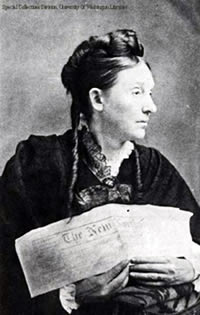
Abigail Scott Duniway (left) arrived in Oregon Territory in the 1850s. Her brother, Harvey Scott, was an early editor of the Portland Oregonian, and did not necessarily support Abigail Scott's campaign for women's suffrage. (Courtesy of Special Collections, University of Oregon. David Duniway collection.)
Residents—perhaps especially newcomers—increasingly seemed to hold that society and government in the Pacific Northwest were new enough to be plastic and accommodating. They need not be satisfied with how people back east had done things; rather, they could try out new ways, and actually improve upon established practices elsewhere. In claiming that the Pacific Northwest was fertile ground for woman suffrage, consequently, Abigail Scott Duniway explained that "All great uprisings of the race, looking to the establishment of a larger liberty for all the people, have first been generated in new countries, where plastic conditions adapt themselves to larger growths." The men of the Pacific Northwest, because of where they lived, cherished liberty, according to Duniway, and were thus more disposed than eastern men to extend its blessings to women. Furthermore, she claimed, the West had given women more opportunities to prove themselves worthy of the vote, and in laboring next to their husbands to tame the country, women had earned suffrage at work that was unavailable to eastern women (Duniway, Path Breaking, 139, 142-43, 165, 172).
By the end of the 19th century and the start of the 20th, similar claims were made on behalf of the region's cultural institutions. When ground was broken in Seattle for the present site of the University of Washington campus in 1894, Adell M. Parker, president of the alumni association, urged the citizens of her state to aspire to new, improved, and regional standards of culture:
"That the West should unfalteringly follow the East in fashions and ideals would be as false and fatal as that America should obey the standards of Europe. Let the West, daring and unprejudiced, discover its own ideals and follow them. The American standard in literature and philosophy has long been fixed by the remote East. Something wild and free, something robust and full will come out of the West and be recognized in the final American type. Under the shadow of those great mountains a distinct personality shall arise, it shall adopt other fashions, create new ideals, and generations shall justify them."
Those who sought to improve or reform the world felt that the relatively new and flexible society of the Pacific Northwest, in the period between 1880 and 1920, offered them better chances for success—or at least more distance from the older ways they were bent on rejecting
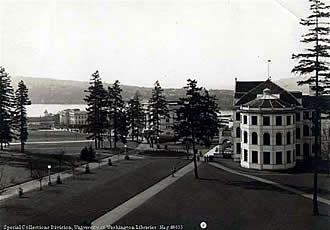
There are other ways of looking at the Pacific Northwest, however, that focus less on the opportunity to reform and more on the need. The historian Earl Pomeroy writes, "If abuse provokes political reform, the Far West became ripe for change as early as any part of the country" (The Pacific Slope [1965], p. 191). We need to keep in mind that many parts of the Pacific Northwest remained quite "unrefined." The populations of urban centers, for example, were still heavily male, and most cities tolerated vice districts that catered to men without families. These districts presented moral problems for emerging, progressive-minded, middle classes, and also represented great opportunities for corruption and graft. Such conditions remind us of how the region's development since the mid-19th century had been dominated by the quest for economic growth. Residents had generally postponed making social or cultural improvements, focusing upon making a living rather than making a nice place to live. Cities like Spokane, for example, had tolerated prostitution as an economic staple—perhaps even a public-health service—rather than moralizing against it. Now, during the progressive period, they turned to making the improvements that would create a more satisfying and respectable home.
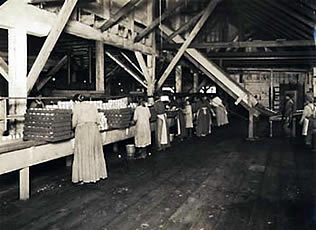 An early view of the University of Washington campus (above) showing Parrington Hall in the foreground. (Special Collections, University of Washington, photo collections. Neg. 4035)
An early view of the University of Washington campus (above) showing Parrington Hall in the foreground. (Special Collections, University of Washington, photo collections. Neg. 4035)
Working conditions--such as those shown in this photograph of both women and young girls canning fish by hand (left)--were part of the reason why reform movements were popular in the Pacific Northwest. (Special Collections, University of Washington, Social Issues Files Ga.)
Reformers in the Pacific Northwest were also reacting to the harsh realities of the regional economy. As discussed in Lesson 15 and the Schwantes textbook, industrialization polarized society between different classes and economic groups. That the economy focused so much on extractive industry for export to outside markets, that working conditions in mines and forests could be so dangerous and depressing, and that so much production was dominated by big, absentee, corporate owners only exacerbated the tensions inherent in industrialization. Northwesterners who had welcomed the railroad to the region (seeing it, not entirely incorrectly, as an economic savior) now, in the era of reforms, began to appreciate the extensive power that transportation companies exerted over the economy and society, and strove to regulate them more. Populists and progressives also proposed a variety of steps to ameliorate the sharp class tensions that had emerged. Populists hoped to recruit workers to their producer-oriented ideology and reforms, while progressives hoped to modify and fine-tune the economic system so as to ameliorate the gaping social divisions that had appeared.
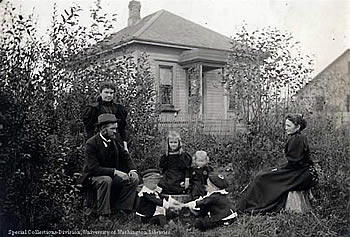 Ideal Family Life (right). Families dreamed for an ideal life in the Pacific Northwest. (Special Collections, University of Washington, Social Issues Eo.)
Ideal Family Life (right). Families dreamed for an ideal life in the Pacific Northwest. (Special Collections, University of Washington, Social Issues Eo.)
The roots of the Pacific Northwest's receptivity to reform and radicalism, then, are complex. On the one hand, there was a great deal of optimism about the region. People believed that life could be better there. Thus a group of families from Pittsburgh, Pennsylvania, decided to move to the Northwest because they expected to improve their condition by going there. "Cannot we make a living here [in Pittsburgh]?" they replied to a reporter's question during the early 1880s. "Well, yes, sort of a living. But every year it is becoming more difficult, as the different trades and avocations become more and more crowded by foreign immigrants, giving employers an opportunity to reduce wages....We hear the most encouraging reports from Washington Territory, and believe it is just the place for poor men to go." This kind of optimism encouraged the idea that the Pacific Northwest would be a better place to live. On the other hand, migrants like these could also easily become bitter when the improvements they anticipated were not attainable, when they discovered that oppressive employers and economic busts treated Washington at least as harshly as they treated the eastern states. It is likely, furthermore, that the disappointment of newcomers only added to the calls for social and political change, and even contributed to the radicalization of those advocating change. As responsive as the Pacific Northwest was to populism and progressivism, it was equally receptive to labor radicalism and utopianism—the focus of the next lesson.
| Course Home | Previous Lesson | Next Lesson |